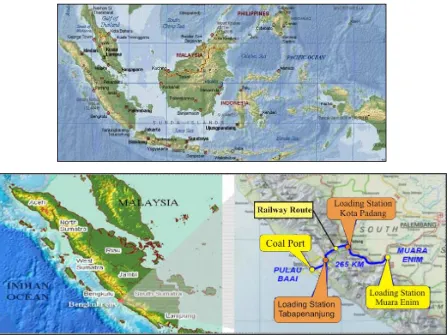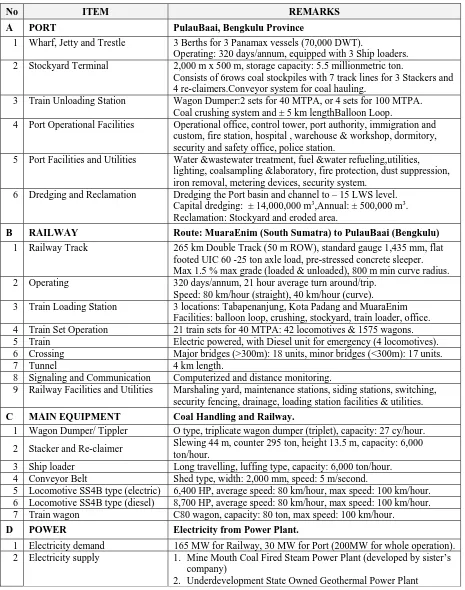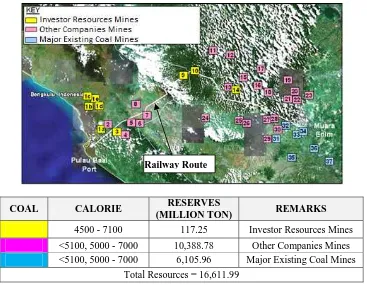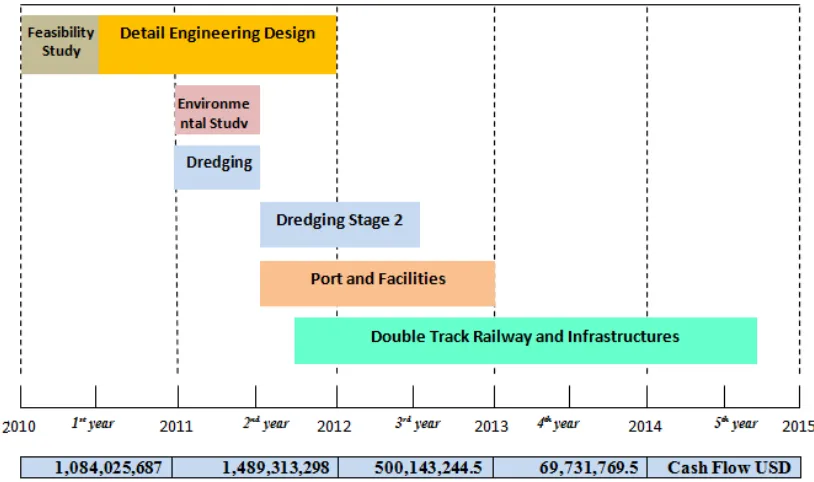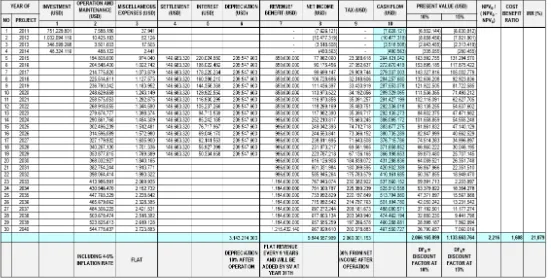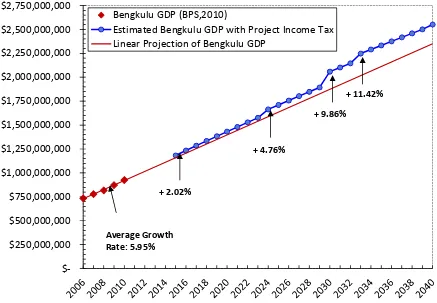Page 1 of 16
THE IMPACT STUDY OF RAILWAY COAL TRANSPORTATION PROJECT TO PROMOTE GDP AND DECREASING UNEMPLOYMENT IN BENGKULU
PROVINCE, INDONESIA
By Paulus Kurniawan1, Kembar Sri Budhi2, Suyana Utama3 and Mahaendra Yasa4 2012
ABSTRACT :
A massive, advanced and integrated coal transportation system (“Project”) of Railway from Muara Enim, Sumatra Selatan Province to new Coal Port at Pulau Baai, Bengkulu, Indonesia is developed by a private Investor together with the Local Government (PEMDA) of Bengkulu Province to optimize the abundant coal resources in the region. A study is conducted to analyze the impact of the introduction of this Project to the Bengkulu economy which is currently considered low. A Gross Domestic Product (GDP) income is adopted as the economy indicator. The study combines the theories of export base and economic base, and cost benefit analysis with the empirical data. The results presented in this paper show the Project financial feasibility with Benefit Cost Ratio of 1.61, Internal Rate of Return of 21.1% and Payback Periode of 5 years, which will provide significant contribution to the Bengkulu Gross Domestic Product (GDP) growth and approximately desreasing unemployment of 821,600 people.
Keywords : Railway Coal Transportation, GDP, Decreasing unemployment, Bengkulu Province, Indonesia.
1. INTRODUCTION
Indonesia has one of the largest coal reserves in the Asia-Pacific region, with proven reserves of 7 billion tons, and these are found mostly in Kalimantan and Sumatra, with resources estimated at 32.9 and 27.3 billion tons, respectively (Indonesian Ministry of Energy and Mineral Resource). Sumatra has 27.4 billion tons of coal resources and 2.7 billion tons of proven reserves, according to the Indonesian Coal Mining Association., suitable for power-generating activities, with sub-bituminous, low sulphur and ash content and average per Kgcaloric value of 5,000 – 6,000 calories.
Although resources in Sumatra are comparable in quantity with Kalimantan, Sumatra particularly in Bengkulu and South Sumatra Provinces is producing and exporting insufficient amounts of coal due to inadequate infrastructure (hauling access and port) for coal transportation. To meet this infrastructural inefficiency, a Private Investor together with the Local Government (PEMDA) of Bengkulu Province develop a massive, advanced and integrated coal transportation system (“Project”) of the following:
1. Doctorate Candidate from Faculty of Economics at Postgraduate Program, University of Udayana, Denpasar, Indonesia Email : pikeke.kho@gmail.com
Page 2 of 16
1. A double track railway of ± 265 km length to exclusively transport coal from major coal mines in Muara Enim, South Sumatra Province and around Bengkulu Province as well as significant coal resources estimated at 16.6 billion metric tons in the immediate hinterland of the railway (Kurniawan, 2010) to
2. New coal port in Pulau Baai, Bengkulu Province, Sumatra, Indonesia. The Project will have a minimum 40 Millions Metric Ton per Annum (MTPA) capacity and 100 MTPA for future plan.
Figure 1. Coal Port and Railway Route from Muara Enim to Bengkulu, Indonesia
The introduction of the Project may have significant positive impact to the Bengkulu Economy. According to Bengkulu Statistic Center (Badan Pusat Statistik / BPS Bengkulu, 2010), Bengkulu Province has low Gross Domestic Product (GDP) income, low income per capita, and high rate of unemployment in Indonesia. Although Bengkulu province has a wealthy abundant of natural resources particularly coal, it has poor infrastructures and geographic disadvantages of being isolated due to difficult natural terrain with the neighboring provinces of South Sumatera, Padang and Jambi, for which might contribute to its economy.
Page 3 of 16
The impact to the Bengkulu GDP may thus indicate the significant and value of the Project to the economy of Bengkulu Province.
Figure 2. Study Methodology
The export base theory was introduced by Harold Innis (England), beginning of year 1920, and developed by North (1955), Dusenberry (1950), Andrews (1953) and deeply stressed by Cramon and Rovayo (2006). This theory refers to the Neoclassical approach to regional growth based on resource areas in North America with the economic growth of the industry by exporting goods and services from region to region because of there sources of an Area (Cramon and Rovayo, 2006).
The economic base theory was first stated by Harry W Richards on in 1973, where this theory states that the main determinants of economic growth in an area directly related to the demand for goods and services from outside the area. Regional development strategies based on this theory usually give emphasis to the national and markets international (Arsyad, 2010).
Cost Benefit Analysis (CBA / COBA) is a technique for assessing the monetary social costs and benefits of a capital investment project over a given time period. The investment criteria methods of project and it application might be determined by five models; 1. Net Present Value / Worth (NPV), 2. Benefit Cost Ratio, 3. Profitability Indexs, 4. Payback Periods, 5. Internal Rate of Return / IRR (Riley and College, 2006, and Sinaga, 2009).
2. PROJECT DEFINITION STATEMENT
The project is to develop an integrated coal transportation system from the coal mines in Bengkulu and Sumatera Selatan Provinces to Pulau Baai Port in Bengkulu Province, capable
THEORY
1. Export Base 2. Economic Base 3. Cost Benefit Analysis
(CBA/COBA)
EMPIRICAL DATA
1. Bengkulu Statistic Center (BPS Provinsi Bengkulu, 2010).
2. Project Feasibility Study (Kurniawan, 2010).
3. Project Design (Pratama Widya, 2008-2010)
4. Project Cost Estimation (Pratama Widya, 2008-2010)
5. Project Supporting Data (References) 6. Research Pustra, Ministry of Public
Works , 2007
7. Dissertation of Economic Analysis on the Special Railway Coal
Transportation from Muara Enim to Pulau Baai Port, Bengkulu Province (Kurniawan, 2012).
CONCLUSION
Page 4 of 16
of high capacity, efficient and reliable system, and equipped with advanced handling equipments to meet the target minimum capacity of 40 MTPA and maximum 100 MTPA for future plan. The railway alignment has been chosen as the most efficient route through the selected area from the mines to the Pulau Baai Port considering all key factors such as geographical obstacles, existing infrastructure, protected, restricted, populated and environmentally sensitive areas.
The coal transportation model is shown in Figure 3, while the adopted key elements in this coal railway transportation Project are shown in Table 1. The required significant amount of electricity for this Project will be supplied from other parties.
Figure 3. Coal Port Plan and Coal Transportation Model
Page 5 of 16
Table 1. Coal Transportation System Key Elements
No ITEM REMARKS
A PORT PulauBaai, Bengkulu Province
1 Wharf, Jetty and Trestle 3 Berths for 3 Panamax vessels (70,000 DWT).
Operating: 320 days/annum, equipped with 3 Ship loaders. 2 Stockyard Terminal 2,000 m x 500 m, storage capacity: 5.5 millionmetric ton.
Consists of 6rows coal stockpiles with 7 track lines for 3 Stackers and 4 re-claimers.Conveyor system for coal hauling.
3 Train Unloading Station Wagon Dumper:2 sets for 40 MTPA, or 4 sets for 100 MTPA. Coal crushing system and ± 5 km lengthBalloon Loop.
4 Port Operational Facilities Operational office, control tower, port authority, immigration and custom, fire station, hospital , warehouse & workshop, dormitory, security and safety office, police station.
5 Port Facilities and Utilities Water &wastewater treatment, fuel &water refueling,utilities, lighting, coalsampling &laboratory, fire protection, dust suppression, iron removal, metering devices, security system.
6 Dredging and Reclamation Dredging the Port basin and channel to – 15 LWS level. Capital dredging: ± 14,000,000 m3,Annual: ± 500,000 m3. Reclamation: Stockyard and eroded area.
B RAILWAY Route: MuaraEnim (South Sumatra) to PulauBaai (Bengkulu)
1 Railway Track 265 km Double Track (50 m ROW), standard gauge 1,435 mm, flat footed UIC 60 -25 ton axle load, pre-stressed concrete sleeper. Max 1.5 % max grade (loaded & unloaded), 800 m min curve radius. 2 Operating 320 days/annum, 21 hour average turn around/trip.
Speed: 80 km/hour (straight), 40 km/hour (curve). 3 Train Loading Station 3 locations: Tabapenanjung, Kota Padang and MuaraEnim
Facilities: balloon loop, crushing, stockyard, train loader, office. 4 Train Set Operation 21 train sets for 40 MTPA: 42 locomotives & 1575 wagons. 5 Train Electric powered, with Diesel unit for emergency (4 locomotives). 6 Crossing Major bridges (>300m): 18 units, minor bridges (<300m): 17 units.
7 Tunnel 4 km length.
8 Signaling and Communication Computerized and distance monitoring.
9 Railway Facilities and Utilities Marshaling yard, maintenance stations, siding stations, switching, security fencing, drainage, loading station facilities & utilities.
C MAIN EQUIPMENT Coal Handling and Railway.
1 Wagon Dumper/ Tippler O type, triplicate wagon dumper (triplet), capacity: 27 cy/hour.
2 Stacker and Re-claimer Slewing 44 m, counter 295 ton, height 13.5 m, capacity: 6,000 ton/hour.
3 Ship loader Long travelling, luffing type, capacity: 6,000 ton/hour. 4 Conveyor Belt Shed type, width: 2,000 mm, speed: 5 m/second.
5 Locomotive SS4B type (electric) 6,400 HP, average speed: 80 km/hour, max speed: 100 km/hour. 6 Locomotive SS4B type (diesel) 8,700 HP, average speed: 80 km/hour, max speed: 100 km/hour. 7 Train wagon C80 wagon, capacity: 80 ton, max speed: 100 km/hour.
D POWER Electricity from Power Plant.
1 Electricity demand 165 MW for Railway, 30 MW for Port (200MW for whole operation). 2 Electricity supply 1. Mine Mouth Coal Fired Steam Power Plant (developed by sister’s
company)
2. Underdevelopment State Owned Geothermal Power Plant
Page 6 of 16
3. EXPORT AND ECONOMIC BASE THEORIES
Figure 4 shows an overview map of the coal mines and resources along the Railway
alignment which has been estimated at 16.6 billion tons of coal resources (Kurniawan, 2010). Referring to the export base theory, the abundant coal resources may promote opportunity for economic growth in Bengkulu Province from coal exploitation, transportation and export through the Pulau Baai Port in Bengkulu.
COAL CALORIE RESERVES
(MILLION TON) REMARKS
4500 - 7100 117.25 Investor Resources Mines
<5100, 5000 - 7000 10,388.78 Other Companies Mines <5100, 5000 - 7000 6,105.96 Major Existing Coal Mines
Total Resources = 16,611.99
Figure 4. Map of Coal Mines along the Railway Alignment
Coal is one of the most important commodities globally today and is one of the main fuel source for the world’s electricity produced. According to U.S. Energy Information Administration the worldwide coal consumption has doubled since 1980, mainly driven by increase in Asia as shown in Figure 5. The Asian demand is dominated by China and India, where the first accounts for 73 percent of Asia’s consumption and almost half of global coal consumption. Further, the domestic demand of coal is also increasing to meet the National energy shortage.
Based on the economy base theory, this promising coal demand in particularly China and India as well as for National market and together with the introduction of this coal transportation Project, will determine significant economy growth in Bengkulu Province.
Page 7 of 16 a) World Coal Consumption by Region (U.S. Energy Information Administration)
b) Coal Consumption Share in Asia (U.S. Energy Information Administration)
Figure 5. Worldwide Coal Consumption
4. COST BENEFIT ANALYSIS
The Project investment value is equal to = Project cost + contingency fee + cost of money. The Project cost covers the entire development cost from design stages, licenses, land acquisition, construction, main coal handling equipments procurement until project hand over. Contingency fee is the unexpected cost incurred during construction due to an inaccuracy, price escalation, and other unpredicted issues, while cost of money is a value of interest during the construction. Table 2 shows the estimated Project investment value, and
Figure 6 shows the cash flow distribution during the Project development which is estimated
3.5 years for construction.
Table 2. Investment Value of the Coal Transportation Project
NO ITEM TOTAL COST (USD)
1 Feasibility Study , Engineering Design and Environmental Study 50,655,375 2 Dredging Work (from existing up to – 15m at channel & basin) 80,006,750 3 Coal Port (for 3 Panamax vessels) including Facilities 310,548,054 4 Stockyard Area (2.000 x 500 m2) including Facilities 364,667,266
5 Double Track Railway (265 km) including Facilities 2,077,341,627
6 Cost of Money, Interest rate during construction 120,000,000
7 Contigency Cost 139,994,928
Page 8 of 16
Figure 6. Project Time Schedule and Cash Flow during Development
Based on the investment value, this Project can be categorized as a Mega Infrastructure Project that requires substantial investment funds. The Financial model adopted for this study is as in the following:
Investor equity : 30%
Loan / external fund : 70% (“Joint In", "Joint Support" and "Public Support" to the potential investor partners, banks and public market)
Page 9 of 16
Table 3. Project Revenue Drivers
No. ITEM VOLUME
CONTRACT RATE
YEARLY REVENUE
Million mT USD / mT Million USD
A
A.1
A.2 Port
Unloading fee at Pulau Baai Port, Bengkulu Channel fee at Pulau Baai, Bengkulu
40 40 5 4 200 160 B B.1 B.2 Railway Coal mines at
intermediate hinterland of railway route,
Major existing coal mines in Muara Enim 20 20 14.5 14.5 290 290 Total 850 Note: contract rate will increase in every 8 years after operation commence.
Table 4. Project Driver for Financial Analysis Assumption
No ITEM REMARKS
1 Inflation Rate Year 2010 : 6.96% (Bank of Indonesia).
Assumed rate : Year 1 – 5 : 6%, Year 6 – 10 : 5%, Year 11 – 30 : 4%. 2 Operation and Maintenance Basic operation : 1%/yr of investment
Basic maintenance : 1.5%/yr of investment
Electricity : USD 0.8/kwh (under development state owned geothermal power plant).
3 Miscellaneous Expenses and Salvage Value
Miscellaneous expenses and royalty : 0.5%/yr of operation cost. Salvage value : 1% of investment.
4 Settlement and Interest Settlement period : 15 years (after construction completed). Loan model : 70% investment (USD 2,200,249,800). Interest rate : 10% flat (Bank of Indonesia, 2010). 5 Depreciation Basic depreciation period : 15 years.
6 Tax Tax value : 30% net income (Indonesian Tax Regulation).
The benefit cost analysis of the Project is conducted based on the Project revenue and cost drivers (Tables 3 and 4). The financial analysis for the first stage of Project lifetime (30 years operation) is summarized in Table 5, where three analysis models are adopted; 1. Cost Benefit Ratio, 2. Internal Rate of Return (IRR), and 3. Payback Periods.
Page 10 of 16
Table 5. Cost Benefit Analysis during the Project Lifetime
Table 5.1 Benefit Cost Ratio and Internal Rate of Return
The cost benefit analysis result shows the key financial values of the Project; Benefit Cost
Ratio of 1.61, IRR of 21.1%, and Payback Periods of 5 years.
The Project benefit cost ratio much greater than 1.0 indicates that the Project is driving benefits from the investment, and according to Gray (1986) is considered feasible.
The Project IRR of 21.1 % is greater than the adopted interest rate or discounted rate of 10% (Bank of Indonesia, 2010), indicating high rate return from the investment. Although the interest rate is assumed flat for the 30 years of Project lifetime, the high IRR value may still accommodate the possibility of increasing interest rate. It is however unlikely that the interest rate may reach greater than 15%, and the current trend shows reduce in interest rate (Bank of Indonesia, 2010). According to the general practice in oil and gas project in Indonesia, the minimum IRR value is recommended 15 % (Sinaga, 2009) due to the high risk factor associated in the energy sector. As considered a Mega Project with high risks, the Project IRR value also meets the above suggested IRR value.
According to Sinaga (2009), a Project with payback period of 5 years is considered adequate for investment.
Page 11 of 16
5. IMPACT TO BENGKULU GROSS DOMESTIC PRODUCT
One of the major Project contributions to the Bengkulu Gross Domestic Product (GDP) is the income tax to the Bengkulu Local Government (PEMDA). Bengkulu and National Income taxes year of 2011 have a contribution of 3.4% and 70% from their GDP respectively (Indonesian Director General of Taxes). The Project income tax is rated 30 % based on the Indonesian Tax Regulation as shown in Figure 7.
Figure 7. Project Income Tax Impact to the Bengkulu GDP Growth
Figure 7 presents the Project income tax impact to the growth of Bengkulu GDP during the
Project lifetime. The Bengkulu GDP growth is optimistically projected linearly based on the statistic data of Bengkulu GDP with a constant price base (BPS Provinsi Bengkulu, 2010) and compared with the addition of Project income tax.
It shows that after the Project operation commencement, the Project income tax will increase the Bengkulu GDP by 2.02% in Year 2015. The Bengkulu GDP growth increases higher by 4.76% in 2024 due to increase in the Project revenue (coal transportation unit rate increase in every 8 years), and 9.86% in 2030 due to diminishing project cost drivers such as settlement, interest and depreciation. With another increase in coal transportation unit rate, the Bengkulu GDP growth is estimated to increase by 11.42% in year 2033. This income tax contribution especially after Year 2024 shows a comparable or higher value with the average GDP growth rate from year 2006 to 2010 (5.95%).
$‐ $250,000,000 $500,000,000 $750,000,000 $1,000,000,000 $1,250,000,000 $1,500,000,000 $1,750,000,000 $2,000,000,000 $2,250,000,000 $2,500,000,000 $2,750,000,000
Bengkulu GDP (BPS,2010)
Estimated Bengkulu GDP with Project Income Tax Linear Projection of Bengkulu GDP
+ 2.02%
+ 4.76%
+ 11.42%
Average Growth Rate: 5.95%
Page 12 of 16
Further, it is estimated that the Project income tax may only contributes 1.98% of the total Bengkulu GDP in the beginning operation of the Project, but it will be a significant income for the Bengkulu GDP in Year 2033, providing 10.25% of the total Bengkulu GDP as shown in Figure 8.
The above discussions indicate that the Project income tax alone provides significant benefits to the Bengkulu GDP growth. This therefore highlights the importance value of the Project to the economy of Bengkulu Province.
Figure 8. Project Income Tax Contribution to the Bengkulu GDP
Further study can be conducted to analyze the impact of this Project development to other economy indicators, such as: income per capita, local and regional developments, employment opportunities, infrastructure development, and other commodities export through Pulau Baai Port, Bengkulu.
6. IMPACT TO BENGKULU UNEMPLOYMENT
Labour is the population of age 15 and up to 64 years. In the last 4 years the number of labours in the Bengkulu Province has increased significantly. The number of labours in Bengkulu Province in 2012 is estimated 1,769,053 people, with an increment of 7.56 % from Year 2005 until 2012. (BPS, 2012)
The quality of Labour education in Bengkulu Province in terms of educational level attained is categorized as relatively low. Generally the educational level attained by the labours in the Bengkulu Province is only Primary School.
Page 13 of 16
Table 6 Percentage of Labour Distribution According to Education Level and Employment in May 2012 ( BPS 2012)
No Labour Distribution Percentage
(%)
Labour Distribution Percentage
(%) A 1 2 3 4
According to Education Level Attained Non educated / primary school drop out and Primary School graduated
Junior Highschool graduated Senior Highschool graduated Academy and University graduated
47.22 21.72 22.89 8.17
According to Employment
Plantation Trading Services Others 58.53 15.31 14.12 12.04
Date on : 7 May 2012 (BPS 2012)
Labour force participation rate (TPAK) is a ratio between the total of labour force with the number of labour in 2012, namely 74.85 %. Therefore, Bengkulu Province has a total of 74.85 % x 1,220,800 or 913,768.8 labour forces.
Followings of the employments to be required due to the projects :
1. Estimated Labour Requirements for the under Construction of Coal Port and Railway Project without their multiflier (domino) effects (Table 7).
Table 7 Estimated Labour Requirements for the under Construction of Coal Port and Railway Project without their multiflier effects
No Item Labour
Requirement Expatriate (Man Month) Skilled (Man Month) Unskilled (Man Days)
A Feasibility Study And Engineering Design 3.043 39.734 746.633
B DREDGING WORK (From Existing Up To – 15m At
Channel & Basin)
7.073 9.079 4.340.079
C COAL PORT (For 3 Panamax Sizing) 3.300 57.750 24.458.675
D Stockyard Area (2.000 X 500 M2) 1.995 12.470 8.009.917
E DOUBLETRACK RAILWAYS (265 Km) And 20 Km
Balloon Loop
6.200 31.719 13.047.958
Total (Person) 515 3.589 39.611
Total Requirement (Person) 43715 person
2. Estimated Labour Requirements during the Operation of Coal Port and Railway in the projects (Table 8)
Table 8 Estimated Labour Requirements during the Operation of Coal Port and Railway in the Projects
Operational Activities
Estimated Labour Requirement (Person)
Expatriate Skilled Unskilled
Jakarta Management Head Office 6 22 10
Coal Port Operation 31 205 237
Coal Railway Operation 23 279 279
Maintenance Dredging 2 15 25
Page 14 of 16
3. Ministry of Indonesian Public Works 2007, has conducted a research that the total contribution of a infrastructure Project development to create job opportunities within the Project itself as well as to other sectors. The result shows a Project worth of 1 trillion rupiah may create employment for 28,000 labours. Therefore, this Project which valued USD 3,143,124,000, may also create employment of 31 x 28,000 labours or 868,000 labours.
Based on the statistical analysis from feasibility study shows that 30 data time series indicates 24,648,000 labours totally could be absorbed during 30 year with average of 821,600 labours every year with standard deviation of 144,450. Employement trend graphs show the labour force tends to increase from year to year (Table 9 and Figure 9).
Table 9 Labour Description Data Figure 9 Labour Trend
7. CONCLUSION
A study is conducted to analyze the impact of the development of coal transportation of railway from Muara Enim, Sumatra Selatan Province to new port at Pulau Baai, Bengkulu, to the Bengkulu economy of Gross Domestic Product (GDP) income. The study combines the theories of export and import base, and cost benefit analysis, with the empirical data. The results presented in this paper shows that the Project is financially feasible and has high attractiveness value for investment. The generated Project tax income from output Investor promotes the Bengkulu GDP growth, and provides major income contribution to the Bengkulu GDP and contribute significantly to decreasing unemployment. This study has shown the significant and important value of the Project to the Bengkulu Province economy and decreasing the unemployment.
8. ENDNOTES
The author wishes to express gratitude to Prof. Dr. Made Kembar Sri Budhi, Drs.MP and Prof. DR. Made Suyana Utama, SE, MS from Faculty of Economics at Postgraduate Program, University of Udayana, Denpasar, Indonesia, as his dissertation promotor and co – promotor respectively, for their sincere guidance and advise for the completion of this paper. Nevertheless, the author feels alone remains responsible for any error and omissions left in this paper.
Statistics
L : Labor (ribu orang)
N Valid 30
Missing 0
Mean 821,60
Std. Deviation 144,45
Minimum 168,00
Maximum 882,00
Page 15 of 16
9. REFERENCES
Arsyad, Lincolin, 2010: Pembangunan Ekonomi Unit, Publisher: STIM YKPN, Yogyakarta.
BPS, 2009: Indikator Kesejahteraan Rakyat / Welfare Indicators, Publisher: BPS, Jakarta, Cataloque No: 4102004.
BPS Provinsi Bengkulu, 2009: Provinsi Bengkulu dalam Angka, Publisher: BPS Provinsi Bengkulu, Katalog BPS: 1102001.17.
BPS Provinsi Bengkulu, 2010: Provinsi Bengkulu dalam Angka, Publisher: BPS Provinsi Bengkulu, Katalog BPS: 1102001.17.
BPS, 2012 : Data from Library of Central Bureau of Statistics, Bengkulu Province (unpublished).
CCCC, 2008: Tianjin Dredging, Contractor, Tianjin, China (unpublished).
CCCC, 2009: First Harbour Consultants, China (unpublished).
CCFD, 2009: China Communication, First Design Institute of Navigation Engineering, Consultant, China (unpublished).
CNR Datong, 2009: Datong Electric Locomotive factory, Datong China (unpublished).
Cramon, Von and Rovayo, A, 2006: Export - Base Theory Georg – August – Universitat, Gottingen, www.uni-goettingen.de/de/...pdf/EXPORT-BASE%20THEORY.pdf.
CRCC, 2009: China Railway 13th Bureau Group, Railway Contractor, China (unpublished).
CRCC, 2009: The fifth Survey and Design Institute of China Railway, Beijing, China (unpublished).
CSR, 2006: CSR Zhuzhou Electric, Locomotive works, Locomotive Factory, Zhuzhou, China (unpublished).
CRSBG, 2009: China Railway Shanghaiguan bridge Group Co, LTD, Railway Contractor, China (unpublished).
CSR, 2009: CSR Yangtze Rolling Stock, Rolling Stock factory, China (unpublished).
Dahlian, 2009: Car Dumper System, Car dumper Factory, Dalian Santeng Port Machinery Co, Ltd, China (Unpublished).
Gray, Clive et al, 1986: Pengantar Evaluasi Proyek, Publisher: Gramedia, Jakarta.
Kurniawan, Paulus K, 2010: Feasibility Study, Coal Port and Double Track Railway from Muara Enim to Pulau Baai Transportation Project to Increase Export Capacity in Bengkulu, under PT. Pratama Widya, Jakarta, (unpublished).
Kurniawan, Paulus K, 2012: Dissertation: Economic Analysis on the Special Railway Coal Transportation from Muara Enim to Pulau Baai Port, Postgraduate Program, Economics Faculty, University of Udayana. (unpublished).
Ministry of IndonesiaPublic Works , 2007: Kajian PUSTRA Kementerian Pekerjaan Umum (unpublished)
Pratama Widya,2008a: Topographical Survey at Pulau Baai and its Surrounding Area Report, (unpublished).
Page 16 of 16
________,2008c: Offshore Geotechnical Investigation at Pulau Baai Report, (unpublished).
________,2008d : Main Equipment Technical Specifications for Bengkulu Coal Transportation Report, (unpublished).
_______ ,2008e: Onshore Geotecnical Investigation Report at Pulau Baai and along Railway Route (± 10 km), (unpublished).
_______,2009a: Enviromental Study at Pulau Baai and Railway Coal Route Plan Report, (unpublished).
________,2009b: Engineering Basic Design of Railway Coal along ± 265 km, at Bengkulu and South Sumatra Provinces, (unpublished).
________,2010a: Engineering Detailed Design of Coal Port at Pulau Baai, (unpublished).
________,2010b: Project Cost Estimation, (unpublished).
QRRS, 2009: Qiqihar Railway Rolling Stock Co, Ltd, Rolling Stock Factory, China, (unpublished).
Riley, Geoff and College, Eton, 2006: A2 Macroeconomics / International Economy Theories of Economic Growth, http://tutor2u.net/economics/revision-notes/a2-macro-theories-of-economic-growth.html.
Shenyang, 2009: Shenyang Mining Machinery Works, Conveyor Belt Contractor and Supplier (unpublished).
Sinaga, Dadjim, 2009: Studi Kelayakan Bisnis dalam Ekonomi Global, Teori dan Aplikasinya dalam Evaluasi Proyek, Publisher: Mitra Wacana Media, Jakarta.
